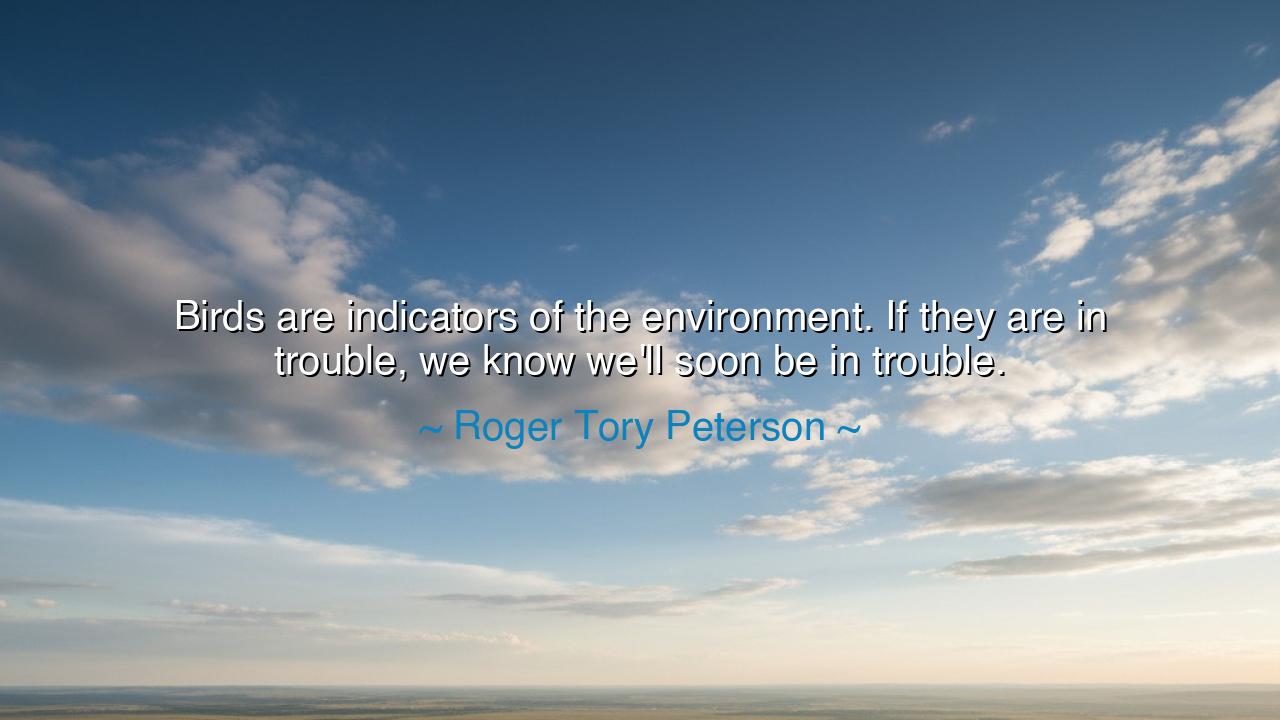
Birds are indicators of the environment. If they are in trouble
Birds are indicators of the environment. If they are in trouble, we know we'll soon be in trouble.






When Roger Tory Peterson declared, “Birds are indicators of the environment. If they are in trouble, we know we'll soon be in trouble,” he spoke not only as an ornithologist, but as a guardian of the living balance between nature and humankind. His words, simple yet profound, echo the timeless truth that the fate of all creatures is bound together. In the song of the bird, he heard the pulse of the planet; in their silence, he foresaw the tremor of decline. His quote is not a warning about birds alone—it is a prophecy about ourselves, for the earth’s smallest winged beings are the messengers of its health, the sentinels of life’s harmony and its decay.
Peterson was a pioneer in modern birdwatching and one of the greatest naturalists of the twentieth century. Through his field guides and tireless advocacy, he opened the eyes of millions to the wonders of avian life. Yet beneath his passion for beauty lay a deeper wisdom. He understood that birds are the mirrors of the environment—that their abundance or absence reveals the health of the land, the purity of the air, and the strength of the ecosystems that sustain all creatures, including man. When forests fall silent and skies grow empty, it is not only a tragedy for nature—it is a sign that the delicate equilibrium sustaining life has been broken.
In the language of the ancients, Peterson’s insight might have been spoken by a prophet or a seer, for it bears the same structure as an eternal law: when the guardians falter, the kingdom falls. Birds, those living symbols of freedom and fragility, have always held sacred meaning. To the Greeks, they were messengers of the gods; to the Indigenous peoples of the Americas, they were omens and teachers. Peterson’s statement carries this same reverence, though expressed in scientific tongue: when these divine messengers vanish, so too does the blessing they signify—the health of the world. Thus, his words bridge both spiritual wisdom and ecological truth, reminding us that science and reverence are but two faces of the same understanding.
History itself bears witness to his warning. In the mid-twentieth century, the widespread use of pesticides such as DDT caused the catastrophic decline of countless bird species, most famously the bald eagle and the peregrine falcon. Their eggs grew thin and fragile, shattering before new life could emerge. For years, few noticed the warning, until Rachel Carson, inspired by the same spirit that moved Peterson, wrote Silent Spring—a book that revealed that the silence of the birds heralded the poisoning of the world. When the skies fell silent, humanity began to listen. Out of that awakening came change—laws to protect the air, water, and wildlife, and a movement that sought to heal what had been broken. Thus, the birds, through their suffering, became our teachers once again.
Peterson’s words carry another, more personal truth: that the health of nature reflects the health of the human spirit. When we lose our connection to the living world—when we cease to notice the flight of the heron, the call of the thrush, or the shimmer of a swallow at dusk—we lose something of ourselves. The trouble of the birds mirrors our own inner imbalance: our disconnection, our greed, our forgetfulness. To heal the earth, we must also heal the blindness within us. To cherish the bird is to remember that beauty and survival are intertwined—that our own well-being depends on the flourishing of the smallest creatures around us.
In this way, Peterson’s statement transcends biology and becomes moral philosophy. It reminds us that stewardship is not a choice but a duty. The Earth does not belong to us; we belong to it. The cry of a vanishing bird is the cry of the Earth itself, calling us to awareness, compassion, and restraint. To ignore that cry is to invite our own suffering, for no species stands alone. We must remember that every wingbeat, every rustle in the leaves, every chirp in the dawn chorus is a thread in the great tapestry of life—and when those threads unravel, the whole fabric of existence weakens.
So let this teaching be passed to all who would live wisely: listen to the birds. Attend to their presence, their silence, their patterns. Let their abundance or decline be your barometer, your prayer, your warning. Plant trees, protect wetlands, refuse the poisons that taint air and soil. Teach your children to recognize the songs of their land, for in those songs lies the measure of our future. As Peterson reminds us, if the birds are in trouble, we are already on that same path. Let us act before silence falls again—before the sky itself forgets how to sing.






AAdministratorAdministrator
Welcome, honored guests. Please leave a comment, we will respond soon